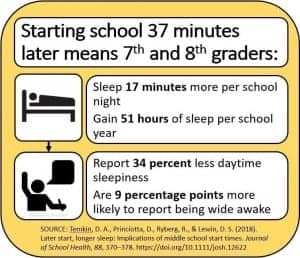A study finds middle schools with later start times, 8 am rather than 7:20 am, help 7th and 8th grade students get an average of 17 minutes more sleep each weeknight. This later start time helps students feel less tired and more alert during class, based on self-reporting surveys from nearly 1,000 students conducted during the 2014-15 school year.
Daniel S. Lewin, PhD, DABSM, CBSM, a study author and the associate director of sleep medicine at Children’s National Health System, collaborated with researchers from Child Trends, Johns Hopkins University, and the University of North Carolina at Chapel Hill to analyze the sleep behaviors and attentiveness of 7th- and 8th-grade students at 11 middle schools within a diverse suburban school district in the Mid-Atlantic region. This study capitalized on the opportunity to analyze different start times for 7th and 8th graders within one school district.
Lewin and the researchers measured the impact later school start times have on student bedtimes, sleep duration, and daytime sleepiness. They chose to study these variables in middle school students since the majority of research about school start times is conducted in high schools. As some high schools sync their starting schedules with sleep science, corresponding middle schools may open earlier to accommodate for transportation logistics.
Based on this analysis, students attending the later-starting schools receive an extra hour and 15 minutes of sleep per week, or an extra 51 hours of sleep per school year. State-level data suggest 38% to 53% of middle school students skimp on receiving 8 hours of sleep each night, even though 9 hours of sleep is optimal.
“Going to sleep earlier to allow for earlier start times is not possible for many teens as their biological clocks are delayed, at least relative to younger children and adults,” says Lewin in a release. “We know that when we do not go to bed and wake at optimal times there are increased risks for physical and mental health problems. Teens who participated in this study were wired to stay up until 10 to 11 pm.”
Lewin and the researchers cite links between teenage sleep patterns and mood, physical health outcomes, and risky behaviors, including aggression and substance use. The review notes middle school allows a critical window for school engagement, which can set up students for academic success.
“Helping teens catch up on sleep is a public health priority since it’s critical to their ability to stay alert in the classroom, on the sports field, and behind the driver’s wheel, which boosts academic performance and prevents injuries,” Lewin says.
The American Academy of Pediatrics recommends 8:30 am as an optimal start time for middle and high school students. This review recommends a 9:15 am start time.
“We haven’t conducted a cost-benefit analysis to analyze how the societal benefits of later school start times may offset increased transportation costs for school districts, but we hope this research serves as a planning tool for parents, teachers, and school districts ,” Lewin says. “As more school districts look at the data, we find parents and administrators are open to experimenting with the status quo, especially if it sets their children, our next generation, up for success.”
This review appears in the May 2018 edition of Journal of School Health, a peer-reviewed journal published by the American School Health Association.




